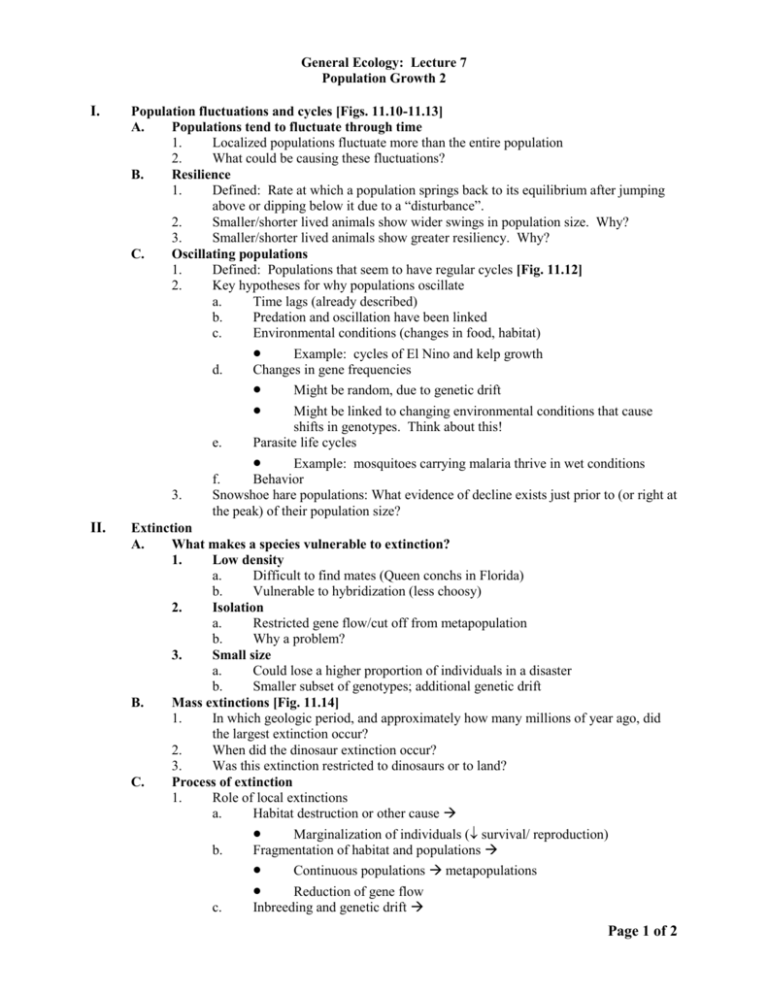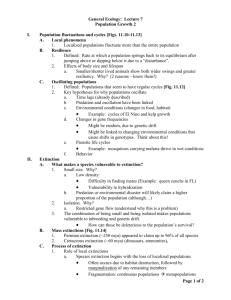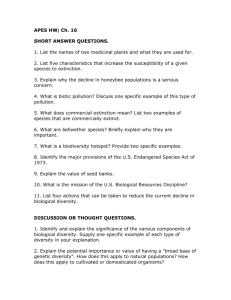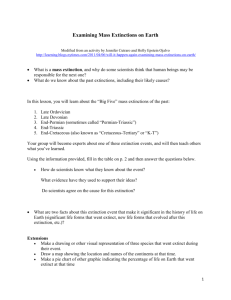General Ecology: Lecture 4
advertisement

General Ecology: Lecture 7 Population Growth 2 I. Population fluctuations and cycles [Figs. 11.10-11.13] A. Populations tend to fluctuate through time 1. Localized populations fluctuate more than the entire population 2. What could be causing these fluctuations? B. Resilience 1. Defined: Rate at which a population springs back to its equilibrium after jumping above or dipping below it due to a “disturbance”. 2. Smaller/shorter lived animals show wider swings in population size. Why? 3. Smaller/shorter lived animals show greater resiliency. Why? C. Oscillating populations 1. Defined: Populations that seem to have regular cycles [Fig. 11.12] 2. Key hypotheses for why populations oscillate a. Time lags (already described) b. Predation and oscillation have been linked c. Environmental conditions (changes in food, habitat) Example: cycles of El Nino and kelp growth d. Changes in gene frequencies Might be random, due to genetic drift Might be linked to changing environmental conditions that cause shifts in genotypes. Think about this! e. Parasite life cycles 3. II. Example: mosquitoes carrying malaria thrive in wet conditions f. Behavior Snowshoe hare populations: What evidence of decline exists just prior to (or right at the peak) of their population size? Extinction A. What makes a species vulnerable to extinction? 1. Low density a. Difficult to find mates (Queen conchs in Florida) b. Vulnerable to hybridization (less choosy) 2. Isolation a. Restricted gene flow/cut off from metapopulation b. Why a problem? 3. Small size a. Could lose a higher proportion of individuals in a disaster b. Smaller subset of genotypes; additional genetic drift B. Mass extinctions [Fig. 11.14] 1. In which geologic period, and approximately how many millions of year ago, did the largest extinction occur? 2. When did the dinosaur extinction occur? 3. Was this extinction restricted to dinosaurs or to land? C. Process of extinction 1. Role of local extinctions a. Habitat destruction or other cause b. Marginalization of individuals ( survival/ reproduction) Fragmentation of habitat and populations Continuous populations metapopulations c. Reduction of gene flow Inbreeding and genetic drift Page 1 of 2 2. 3. 4. d. Local population wiped out by disaster e. Many localized extinctions Species itself is threatened or eliminated Deterministic causes of extinction a. Occurs due to force or change with continued effects from which there is no escape for the species Example 1: Asteroid/climate change theory (Cretaceous) Example 2: Loss of the Great auk, Pinguinus impennis What was their initial distribution like? What led to their extinction? Stochastic causes of extinction a. Occur due to random events that are not continuing Examples of stochastic events Usually just reduces a population, but small populations can be wiped out. Links between deterministic and stochastic causes of extinction a. Heath hen example (see text for details!) Study questions (see also questions in body of study guide!) 1. What is meant by “resilience” of a population? Why are species comprised of small individuals subject to wider swings in population size? Why are species comprised of small individuals often more resilient than those comprised of large individuals? 2. List/explain (1-2 sentences each) several factors that might cause a population to oscillate. Be familiar with the specific examples given in class for oscillations due to environmental conditions and oscillations due to parasites. How might these two types of phenomena (i.e. environmental cycles and parasite cycles) be related? 3. What characteristics of a population or species make it vulnerable to extinction? List and then explain the cause/effect relationships. 4. What deleterious effects might inbreeding and genetic drift have on populations to make them more vulnerable to extinction? 5. Does extinction of a species occur all at once? Explain. 6. What is the largest major extinction that occurred on earth? You should be able to name it and indicate approximately when (how many millions of years ago) it apparently occurred. 7. What extinction event is responsible for the disappearance of dinosaurs, ammonites (giant, shelled cephalopods) and many other species on earth? You should be able to name it and indicate approximately when (how many millions of years ago) it apparently occurred. 8. Define and compare the causes of deterministic vs. stochastic extinctions. 9. Use the heath hen example to explain how deterministic and stochastic factors can work in tandem to cause extinction. 10. What human-related factors are most responsible for recent extinctions? 11. Don’t forget the other questions buried throughout the study guide! Page 2 of 2









